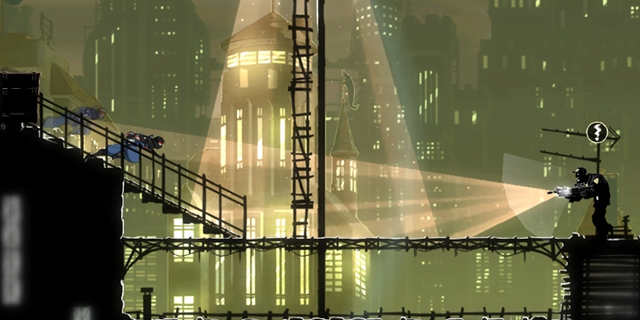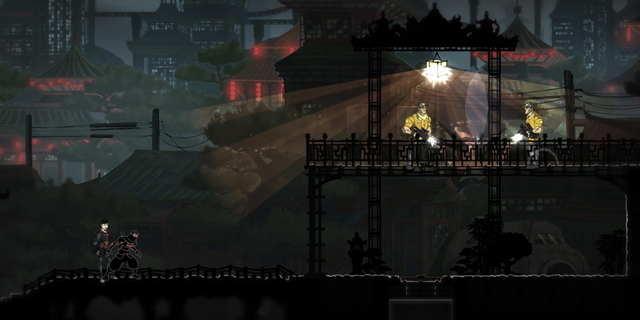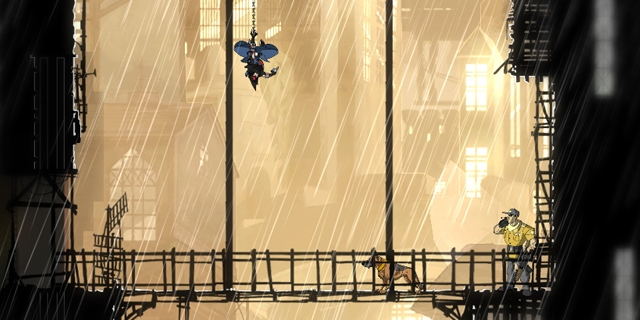
There are many stealth games I hold near and dear to my heart, and yet there haven’t been too many recent examples that capture what I love about the genre. This is where Klei Entertainment, the team behind the colorful and brutally violent Shank series, steps in with their take on the genre. Mark of the Ninja is a game that manages to make the familiar feel fresh and exciting again, and one that shows off the developer’s talents the best way possible.
If you’re at all familiar with other Klei titles, then you probably won’t be surprised to hear that Mark of the Ninja is a gorgeous game. Its fluid animation and use of vibrant colors set it apart from the flood of other, similarly-styled 2D games. There is a lot to be said about the visuals, including how well they coincide with the audio. When sneaking around, you’ll often be able to see visual cues that provide you with a better context of the sounds around you as well as the position of the different enemies. The presentation provides you with more than just a nice looking game as it’s all crafted perfectly around the core mechanics.

Each mission is structured in a linear fashion, but as you unlock new items and techniques, new ways to approach the different scenarios open up to you. When a mission begins, you are thrown into a large level with an objective or series of objectives that you must complete. Scattered throughout the many levels you will explore throughout the game are a multitude of different enemies, traps, and ways around these different obstacles. Sometimes sneaking right through the front door of a room might seem like the best approach, while other times you’ll find a vent or a way to sneak around the room entirely. Each path provides different challenges, but they allow for enough experimentation so you never feel locked into one specific path.
The items you have at your disposable will also come in handy, as they will allow for different ways to distract or dispose of the guards you come across. Your basic item is the dart, which is unlimited and allows you to destroy lights or distract enemies by hitting other environmental objects. Distraction items, such as smoke bombs or noise makers, are necessary for, well, distractions, and also quick escapes. And then the attack items, such a spike mines or poison darts, allow you to kill enemies without them even knowing you were there. And as the game slowly introduces new mechanics to you, such as the ability to freeze time before using any of your items in order to better plan out your approach, you will always find new and exciting ways to tackle each encounter.

Depending on how you approach enemy encounters, whether you sneak by them or kill them, hide the bodies or use them as distractions for other guards, all adds up to a score you are given. This is used to unlock points that you can spend on upgrades, such as new stealth kills, items, and other skills. There are also a handful of different challenges that you can complete in each level (such as getting through a specific area without being seen or killing enemies a certain way) and collectibles that add to these points and eventually allow you to unlock new and exciting ways to approach future scenarios.
All of these mechanics work exceptionally well because of three key elements. The first is the excellent level design. The game rewards exploration and experimentation, and each level ups the ante by introducing new traps or enemies to continue to throw you off guard. The game never gets tedious or extremely difficult, and completing a difficult section of a level feels rewarding in many ways. As mentioned before, they are fairly linear levels, but they never once feel that way when you’re in the thick of it.
The second element is the expert use of lighting. The visuals are a key component to the gameplay, as is the lighting itself. Most stealth games require you to rely on hiding in the shadows to avoid being caught, but in Mark of the Ninja, this idea is presented to you through the lighting in a fantastic way. You will always know when you are hidden in shadows or exposed in the light for enemies to easily see you. And certain levels, such as a couple that take place during storms, play with this mechanic even more. If you’re outside and lightning strikes, the added brightness could easily give away your position. Little touches like that add a lot to the experience.
The third, final, and most important element that makes this game such a success is the feel of the controls. They are precise and, once you learn the game’s mechanics, you will never once have to fight the controls to do exactly what you want to do. They are clingy, but not so much so that they ever interfere with your movements. Whenever you are able to clear an entire room of enemies without a single one of them even realizing it, you feel almost like a professional, and the controls help make that possibility a reality.
It’s rare to find new stealth games that feel familiar, yet do so much right that they become as legendary as the games that inspired them. Mark of the Ninja is one of those games. Thanks to its visuals, controls, and all around brilliant game design, this is one of the year’s best games and one you don’t have to be a fan of stealth games to enjoy.
Pros: Brilliant visuals and use of lighting, precise controls, finely crafted levels that reward experimentation
Cons: It ends



















